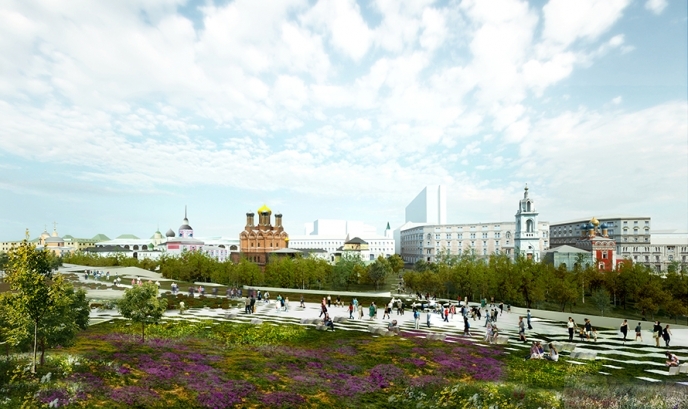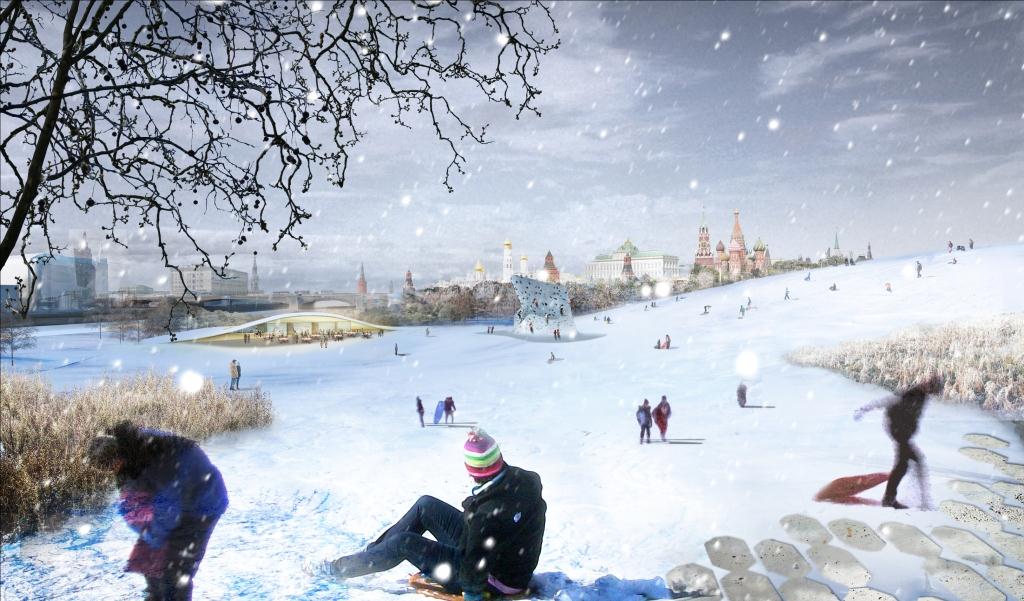A Unique Vegetation Cover Is Created in Zaryadye Park

A natural cover of perennial plants typical for each of the featured landscapes will be created in the Zaryadye Park, said Sergey Kuznetsov, Chief Architect of Moscow, the Head of the author designer team of the Park.
According to mos.ru, vines, fern and steppe almonds will grow two steps away from the Kremlin. The rich vegetation of the future Park will be divided into several natural landscape zones characteristic of our country. An artificial microclimate will be created in the Ice Cave and the Glass Crust.
‘Special backfill will be created in every area of the Park, which will allow cultivating plants not typical for the central part of the country.The specialists of the N.V. Tsitsin Main Botanical Garden and the biological faculty of Lomonosov Moscow State University prepared the composition of this soil.The ground was already filled in the western part of the Park.Trees will be planted in autumn. As Sergey Sobyanin previously said, the opening of the new Park will be scheduled for September 2017 — the 870th anniversary of Moscow’, — says Sergey Kuznetsov.
According to the concept there will be four natural areas: tundra, forests divided into zones: coniferous forests, deciduous forests, birch groves and riparian forests; meadows and steppes.
The plants of the climate zones will be depicted in the Park using landscape replicas, that is, it will be species characteristic of the midland Russian nature well adapted to the urban environment
From the Red Square, Zaryadye visitors will walk into the birch grove. Here, deciduous trees including the silver birch and the white birch will be planted. The height of the white birch reaches up to 15 meters, and it mainly grows in Europe and is protected in natural reserves. The silver birch is even higher — 25 meters.
Low-growing and creeping plants of the tundra will extend along the Varvarka street. Here in the Park, guests will see the birch too, but i twill be a dwarf version, as well as the mountain pine and even such rare species as the downy willow
The meadow area will become one of the most fragrant zones of the Park. Bluebells, cornflowers, clover and meadow geranium will bloom here after a long winter. Visitors of the Park will see medicinal plants here such as St. John’s wort and chicory.
The riparian forest will amaze the guests with a variety of aquatic and wild flowers, trees and deciduous shrubs, which will grow along the embankment of the Moscow River. One will be able to see white water lilies, yellow irises, buttercups, forget-me-nots among the spreading branches of yellow and Siberian willows. And the scent of the blossoming bird cherry will be in the air in late spring.
.jpg)
The Glass Crust will shelter subtropical plants at a temperature ten degrees above the average for Moscow, which is typical for Sochi, for instance
‘There will be no palm trees, of course, because the Crust has no side walls and it’s not a greenhouse. There will be a small area on the southern slope typical of Sochi nature, with yew trees, rhododendrons, barrenworts, and junipers, that is, the plants that normally grow in Moscow. But they will be covered in winter’, — say the experts of MAHPI (Polyansky Moscow Architectural Art and Design Institute), the designer of the Park.
The Park vegetation is designed to create a barrier-free environment: the walkways do not have border stones and obstacles so they will be surrounded by perennials tolerant to foot traffic. The so-called pixel paving will gradually change from continuous to sparse, and, in the end, the visitor will be able to go directly into the ‘wilderness’ and to take a closer look all the plants. ‘And here, for example, in the meadow, the so-called Pskov hill, which is quite a large place — we will mow down grass to form walking paths. There will be quite a lot of paths for walking up the hill to see the surroundings, the Moscow River and the Kremlin; the designated paths will help to protect the rest of the meadow. People will eventually walk everywhere but we will try to organize the traffic somehow,’ — says an expert from MAHPI.
Special maintenance maps for the plants in each natural zone were drawn so that the operating entity had all the necessary documents on landscaping maintenance and restoration.
- Tags:
- Zaryadye





